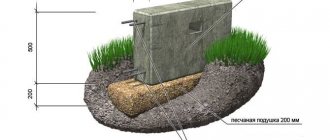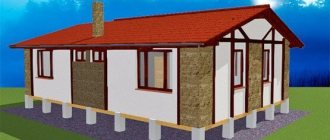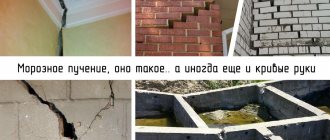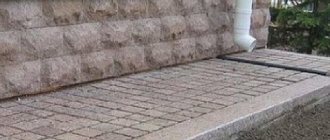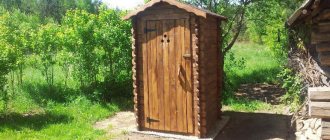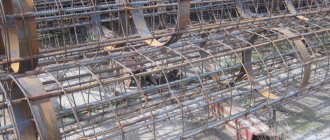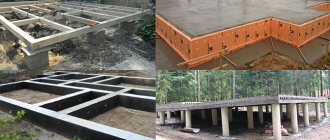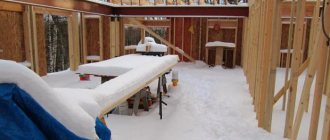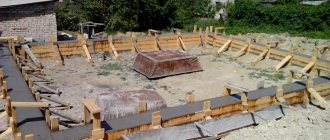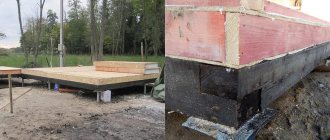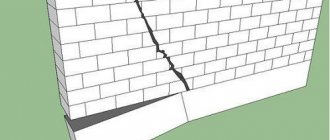Features of peat soils
Building a foundation on peat soil is fraught with great difficulties. This is due to the characteristics of the peat bog:
- over time, peat changes its properties due to the constant decomposition of the organic substances it contains;
- low load-bearing capacity, has high compressibility under load;
- when the groundwater level rises, it increases in volume;
- prone to seasonal heaving;
- is an aggressive environment in relation to concrete and reinforcement.
When building a foundation on peat, it is especially necessary to compact the concrete in the formwork and waterproof the underground part of the foundation.
Peat for goldfish
Some people cannot imagine themselves without a summer house, others cannot imagine themselves without fish in an aquarium. It turns out that fish also need peat, although not ordinary peat, but special peat, which can become a goldmine for an enterprising person.
“Yes, that’s true, peat is needed for aquarium farming,” stated Anton Petrovich, associate professor of the department of modeling closed ecosystems. “But this peat should be extracted from the deepest layers of high peat bogs, which are characterized by a high degree of decomposition. It looks black and brown. Such peat stabilizes or even lowers pH in a slightly acidic region, which, firstly, promotes the growth of beneficial algae, and, secondly, temporarily blocks the proliferation of fungi and bacteria.”
Such peat should be prepared under sterile conditions. First, his “professional suitability” is determined. To do this, the peat is kept in distilled water for 20 hours, followed by aeration. Only peat whose pH does not increase after this procedure is suitable for further processing. Next, the peat is boiled in distilled water for thirty minutes, then carefully filtered.
“You understand that the profitability of the business is quite high,” sums up Associate Professor Anton Petrovich. — Transport costs are low, as are storage costs, and start-up costs are very low or non-existent. But there is one nuance - it is better to do this business in large cities, where there is a demand for decorative aquariums.”
As you can see, peat is not only a natural material, so hated by Muscovites because of the summer smog. Peat is a very interesting material that can and should be used to build a successful small business on it. We should not forget that there are many more areas of application for peat than those described in this article. However, now we have only covered the peat business that does not require large investments. After all, one way or another, the path to the top starts small.
Possible foundation options
In order not to make a mistake with the choice of foundation design, it is necessary to carry out a geological analysis of the soil at the house construction site. If this is not done, then there is a high risk that even at the stage of drainage of the site, peat will settle due to changes in the groundwater level. This means the foundation will sag.
Based on the values obtained as a result of the analysis and the developer’s capabilities, one of the most suitable types of foundation is selected:
- If the thickness of the peat layer is 1.5-2 m, and underneath there is a sandy or clay layer, then you can build a slab or monolithic strip foundation with complete or partial replacement of the soil.
- When alternating layers of peat and there is no need to have a basement in the house, a good option is to build a pile foundation.
Since the depth and occurrence of peat can be different even in one area (one or several layers, a continuous layer, etc.), you should not rely on the experience of your neighbor!
Dry toilets
There is another type of activity that has a great future. Previously, when a person bought a dacha, the first thing he did was take a shovel and dig a cesspool for the toilet. Now this design has been replaced by dry closets with peat filling. Their popularity is growing from year to year. This means that the demand for peat fillers will only increase.
So, if you have taken up this noble cause, then the first thing you need to do is purchase a dryer, chopper and mixer. The volumes of the apparatus should be determined from the final productivity.
“The peat must be thoroughly dried,” advises Anna Maksimovna from Arkhangelsk. - But don’t get carried away, too dry peat is a fire hazard. Next, you should thoroughly grind it and mix it in a one-to-one ratio with dry sawdust. Then package it in twenty-liter packaging. This is the most popular volume. It's enough for a family of three for a weekend. If you also work on the design, then all kinds of supermarkets will be happy to take your product.”
But it’s worth considering that the production of peat fillers for composting toilets is more of a seasonal business. It's better to do it in the summer. At this time of year it is easier to extract peat and the demand is higher. After all, mostly summer residents buy such fillers.
“The equipment required for such work is very simple; a smart man can make it himself,” continues Anna Maksimovna. “It’s not an oil business, of course, but it’s enough for bread and butter.” A year ago my husband was laid off, and now he works for me. So, first you should scavenge or prepare peat and sawdust at a ratio of 1.5:1 with a moisture content of peat of 70 percent and sawdust of 15 percent. But the proportions may be different, and they depend, first of all, on humidity. Next, the peat and sawdust are thoroughly dried. Then they mix, and the toilet mixture is ready. All that remains is to deliver it to the buyer.”
You can extract peat yourself if there is a peat bog nearby, or buy it from a wholesaler. The price starts from 450 rubles per cubic meter. It is better to purchase sawdust from wood processing enterprises, which sell them at a symbolic price. On the market, a 120-liter bag of sawdust sells for 100 rubles or more.
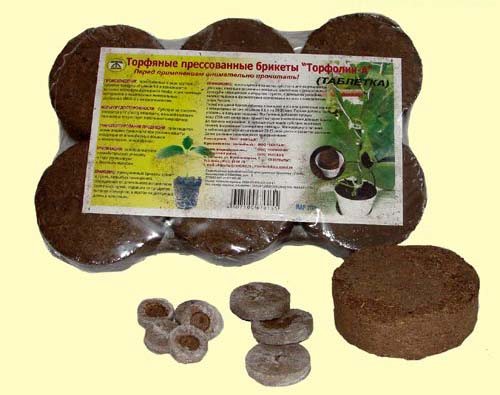
Construction stages
Strip and slab foundations
Complete replacement of peat soil (removal of peat) is economically feasible when the peat thickness is no more than 2 meters. In the case of constructing a strip foundation, trenches are dug; if a monolithic slab is planned to be poured, a foundation pit is prepared. Peat is excavated down to a layer of sand or clay.
The bottom of the pit or trench is covered with geotextiles, then covered with sand, crushed stone or sand-gravel mixture (SGM). After compaction, they proceed directly to installing the formwork, tying the frame and pouring concrete.
If the thickness of the peat layer is high and it is impossible to completely remove it under the building site, then partial removal of the peat layer is allowed. After completing the preparatory work for installing the sand and gravel cushion, a high strip foundation is poured. You can start building a house only after this foundation has stood for at least 2 years and the peat has settled.
Columnar foundation
If the results of a geological study reveal that the thickness of the peat layer exceeds 2 meters, then from an economic point of view the most effective option would be to build a pile foundation. Among its advantages are:
- high load-bearing capacity;
- short construction period;
- low cost.
Depending on the project of the house being built, the piles can be:
- bored;
- driven reinforced concrete;
- screw.
The depth of the base of the piles is not less than the depth of soil freezing. They must rest on a durable layer. If it is decided to build a foundation on bored piles, expansion is done in the lower part of the wells to increase the bearing capacity. Asbestos-cement pipes or roofing felt are used as formwork, which later serve as waterproofing. Reinforcement of bored piles is carried out with reinforcement with a diameter of at least 8 mm. For pouring, it is best to use concrete grade M400. During pouring, special attention is paid to compacting the concrete.
The final stage is the construction of the grillage. For it you can use concrete grade M300.
How to lay a foundation on peat soil
In our country, peat soil is quite common. A lot of people live in places where previously there were endless swamps. However, it is difficult to build housing on a peat bog, since it is not always possible to build a solid foundation on unstable soil.
Peat soil is greatly deformed under the influence of heavy loads, and, in addition, can greatly change in volume. For example, when water inside the soil freezes, it swells. Organic matter is constantly decomposing inside the peat bog, which also affects its volume. Among other things, peat soils have high acidity and quickly “kill” concrete and metal. How to create a good, durable foundation in such conditions? What to choose?
What kind of foundations can be made on peat soil?
To do this, you need to know the composition of the soil, including the depth to which the peat layer lies. The type of future foundation largely depends on this.
Options for the location of peat on the site may be the following:
- A continuous layer of peat, mineral soil was not found throughout the entire compression thickness.
- A small layer of peat soil rests on a base of mineral soil.
- The peat layer enters the site from several or one side.
If the peat layer is shallow, does not exceed, for example, 2 meters, and below there is good dense soil, then it makes sense to completely remove the peat from the site. After cleaning the future construction site, you can arrange the following types of foundations:
- Small with sand filling.
- Slab with sand backing.
- Deep foundation with the possibility of constructing underground premises - basements, garages, parking lots.
Sometimes the area is only partially cleared of peat. Then the following options are possible:
- Deep strip foundation.
- Foundation resting on reinforced concrete columns.
Peat+straw+dung=happiness
The article “Growing Mushrooms: Champignons and Oyster Mushrooms” states that a successful mushroom business is not possible without peat compost. Well, there are quite a lot of mushroom pickers in Russia today. So if you have a peat bog and a poultry farm nearby, then God himself commands you to make mushroom compost.
“In the Vologda region, where I was born and have lived for forty years, there are no visible peat bogs,” says local businessman Konstantin Dmitrievich. — Once upon a time, peat was mined here using huge combines, like monsters from the books of the Strugatsky brothers. Now they've abandoned it. There is no work in our village, young people are fleeing to Moscow, which is not waiting for them. The rest are drinking themselves to death. But, thank God, I found my formula for happiness. And it looks like this: peat + straw + dung = money.”
| This is interesting! |
| Franchising business Taxes for an entrepreneur Business idea: sausage production Business idea: making pancakes Business idea: production and sale of kvass How to write a business plan How to build a business from dust How to register an individual entrepreneur yourself Self-registration of a legal entity Secrets of choosing used equipment Franchising: What? For what? Why? Outsourcing: What? For what? Why? Dry cleaning as a business with high income Sensation: affordable business with 300% profitability! Market Reviews |
We are talking about compost for champignons. As Konstantin Dmitrievich admitted, his grandfather, a biologist by training, taught him to make the highest quality compost. Everything else was taken care of by Muscovites - one well-known mushroom company that buys compost in bulk, packages it in beautiful packaging and sells it throughout the country.
“The quality of my product is excellent,” the entrepreneur boasts. — From a ton of compost I get 350 kilograms of excellent champignons. Many competitors have a maximum of 250 kilograms. One of my secrets is a unique compost production technology, which I maintain very punctually, with German pedantry. In addition, I found a low-lying peat bog unusually rich in nutrient medium. This is my know-how. The peat business won't work at all. Let me tell you for beginners, the devil is in the details. But in principle, good peat can simply be packaged for fertilizer.”
Construction of a pile foundation on peat soil
If the house is installed on piles, they must penetrate the entire peat layer right through to a dense layer. Metal piles cannot be used, since peat is an acidic and highly humid environment, and metal will not last long in it.
On peat soil, columnar concrete piles are installed, made of strong concrete, which are erected in deep pits. The pit must be deeper than the frost line. Most often, the column is poured into formwork with a pre-installed reinforced frame. Next, waterproofing is done, a backfill is made of drainage sand, which is protected from peat by a layer of geotextile. Such a foundation is arranged if the peat goes no more than 2 meters deep.
Another foundation technology developed specifically for unstable soils is the so-called “Scandinavian”. Used most often in cold climates.
The work algorithm is as follows:
- A bedding is installed, a layer of insulation is laid;
- A strong frame is knitted from reinforcement;
- The concrete heating system is installed and tested under full load;
- Concrete mixture is poured into the prepared formwork.
This method is quite expensive, but is popular because the slab is very stable and durable.
New publications are published daily on our Yandex.Zen channel
Selecting a foundation for a house on peat soil
Peat is soil consisting primarily of the remains of bog plants. Being fibrous and loose, such soil requires drainage before full construction can be done on it. Even after draining the wetland, there is no guarantee that the peat mass will not have to be removed and a pit built, although this is usually not necessary.
When building on peat soils, pile foundations are the most successful, although there are practices of using columnar and monolithic types of foundation.
Due to the specific nature of working on peat soil, additional requirements are placed on the foundation. There are two main trends in construction on soft soils:
- Either the foundation base sinks deep into the soil and ultimately rests on solid base rock,
- or the foundation rests on the ground surface, but due to the large supporting area it is able to bear the weight of the building.
For a number of reasons, the main of which is the occurrence in the future of the effect of settlement, movements in the ground and loads in the vertical direction, the second option is most often considered in relation to temporary buildings.
Work on the construction of buildings on a foundation immersed in the thickness is always quite labor-intensive. They often require the use of technology, although in some cases a pile foundation for a house on peat soil can be installed by a couple of people, provided that no preliminary drilling is required and the pile is immediately immersed in the ground.
Piles for peat soils
A classic pile foundation made of reinforced concrete products, which are driven into the soil using a pile driver , is not always suitable for swampy areas with a predominance of peat in the soil. Such a foundation is installed only on a solid base. If the peat layer at the construction site is of insignificant thickness, and after it there are hard rocks, on such soils it is possible to make a foundation of reinforced concrete piles. In this case, the piles rest on a rigid base, which guarantees the stability, strength and durability of the building.
It’s another matter if the peat layer has a predominant thickness of more than 2 meters. In this case, it is possible to build two types of pile foundations, using:
- bored piles;
- screw piles.
Foundation on peat bogs: bored piles
The technology for constructing a foundation using bored piles is complex. First of all, this is due to the need to perform deep casing wells. In peat soils, digging deep wells is associated with large labor costs, as well as the cost of using expensive special equipment.
It is especially difficult to work in water-saturated peat soils when the groundwater level reaches a high level. When watching the video you will learn a lot of information about bored piles. It is necessary to lower a pipe into the well and install a reinforcement cage made of special reinforcement in it. The frame can be tied using tying wire or welding. Then the concrete mixture is poured into the prepared well through a special funnel.
It is very important to prepare the solution correctly; this will require cement grade M400 or higher. The solution is mixed from cement, sand and crushed stone in a ratio of 1:3:2, and it is necessary to use a small amount of water - the solution should be thick and plastic. Crushed stone must be used of the highest quality, acute-angled, of different fractions. Concreting of the pile is carried out quickly and without interruptions to prevent the formation of artificial cracks.
A grillage is erected on the finished bored piles, on which the walls of the building are actually mounted.
Foundation on peat bogs: screw piles
By using a peat foundation made from screw piles, the work can be made much easier. The piles are screwed into the ground by hand; no special equipment or expensive materials are required. The video details the pros and cons of screw piles.
There is one big disadvantage - screw piles made of metal in wet peat soil are very susceptible to corrosion, so protective measures are necessary to treat the supports before screwing in with special compounds.
Constructing a foundation of screw piles in marshy areas has some advantages:
- The building is located above ground level, so the cost of waterproofing can be avoided.
- The technology of installing a house on screw piles allows you to mount a building on any site, even with the most uneven soil.
- Ventilation of the lower crowns of the house prevents rotting processes.
- Piles have a low cost, which significantly reduces the cost of construction.
Screw piles are screwed into the ground according to preliminary markings. After completion of the work, the upper part of the piles is cut to certain marks. There are two technologies for constructing buildings on screw piles - with and without a grillage.
Types of foundations popular in construction on peat
Consider the following types of foundations for swampy areas with peat soil:
- Monolithic foundation. The basis of a multi-storey building for permanent residence, a monolithic slab allows you to minimize vertical loads on the walls of the house and avoid deformation even after many years of use. The disadvantages of a monolithic foundation are technological complexity and high cost, as well as high consumption of material - after all, you will have to fill a whole pit under the future house.
- A widened/column foundation is one in which the building rests on a series of concrete/reinforced concrete pillars, the total area of which allows them to support the weight of the structure. The “bollard” system can be equipped with a grillage and requires careful calculation.
- A pile-screw foundation is most often offered as the best alternative for soft, rocky, loose soils and construction on an inclined surface. The advantages of such a foundation are a small amount of installation work, the ability to bear a load with a low weight of foundation elements, and versatility. At the same time, pile foundations are usually used for low-rise construction - garages, bathhouses, temporary facilities... however, there are exceptions. More specifically, the advantages and features of screw piles will be discussed below.
Each screw pile is a hollow steel pipe with a cone-shaped end and a blade attached by welding. The surface of the pipe is usually treated with epoxy enamels to protect against corrosion. For different soils, special types of piles are used, differing in the shape of the tip and blade. Pile foundations are actively used for peat soils: the piles provide reliable support and exert little pressure on the soil, and concrete can be poured into the pipe to increase strength. Another important advantage of a pile foundation is the possibility of construction on an uneven surface, such as a river bank, a wooded slope, or an area with a significant difference in elevation.
Advantages and features of a pile foundation on peat soil
The following factors favorably distinguish the practice of using pile foundations.
- They have a lower cost with the same load-bearing capacity as monolithic and strip foundations;
- High service life - up to 150 years or more;
- Short installation time and low installation complexity;
- Possibility of installation in winter, in frozen ground, and in any weather;
- High resistance to heaving, movement, and groundwater;
- Ability to replace and repair piles;
- High strength guarantees earthquake resistance.
A pile-screw foundation can be calculated and installed on your own. This is another difference from columnar foundations, which are recommended to be installed and designed with the help of professionals. After all, the calculation of a columnar base requires attention to the density of the frame and the nature of the grillage, to the shape and location of individual elements, and compliance with the maximum load threshold. On unstable peat soil, such foundations are more vulnerable, and their installation costs a decent amount.
